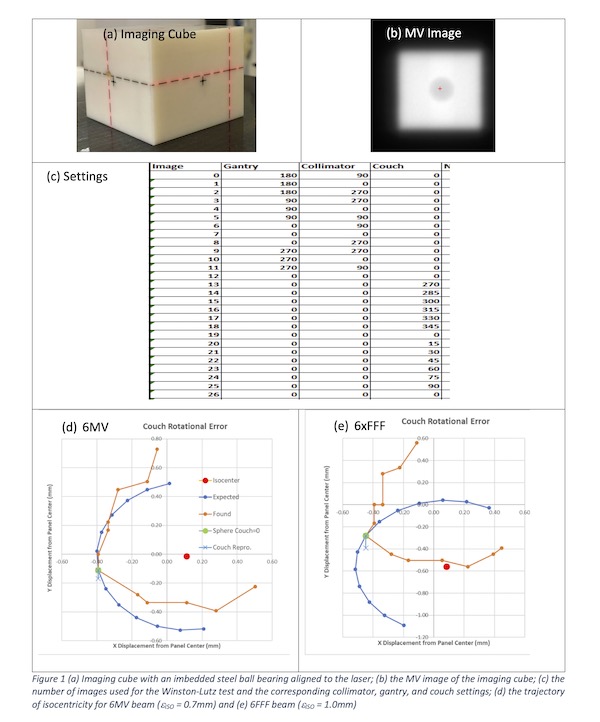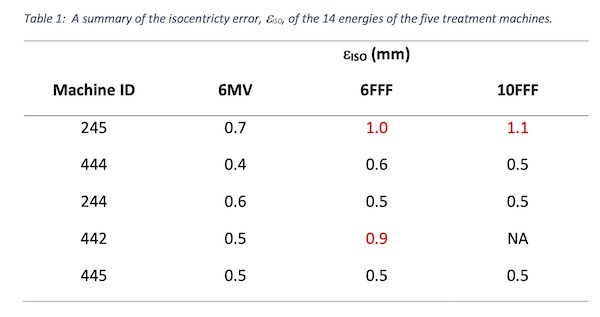An investigation of the Energy-Specific Isocentricity on SABR C-arm Linacs
PO-1725
Abstract
An investigation of the Energy-Specific Isocentricity on SABR C-arm Linacs
Authors: Seng Lim1, Michael Lovelock2, Laura Happersett1, Jean Moran1
1Memorial Sloan Kettering Cancer Center, Medical Physics, New York, USA; 2Mount Sinai Hospital, Radiation Oncology, New York, USA
Show Affiliations
Hide Affiliations
Purpose or Objective
The isocentricity(Ciso) of a machine is defined, and QA’d by using only the 6MV beam. This study investigated the Ciso variations between 6 MV and flattening filter-free (FFF) treatment beams on C-arm Linacs. If Ciso discrepancies persist between beams, OAR doses could increase and be clinically significant for stereotactic ablative radiotherapy (SABR).
Material and Methods
Isocentricity was measured on 6MV, 6FFF, and 10FFF beams of five Varian TrueBeams using a Winton-Lutz (W-L) type test. A phantom with a 6.35mm steel ball bearing was placed approximately at the isocenter(ISO) using the lasers, ISOL (Fig 1a). A 2.0x2.0cm MLC-defined aperture was used for the irradiation (Fig 1b). The Ciso of the radiation ISO (ISOR) of each beam was measured by exposing 27 fields at different gantry, collimator, and couch angles as listed in Fig 1c. The ISOR was determined as the position of the average aperture centers of the images taken at the collimator angles of 90 and 270 at the four cardinal angles. Thus the displacement of the sphere’s placement (ISOL) from the true radiation isocenter, ISOR, can be determined. Fixing the gantry and collimator at 0 degrees, the couch was rotated from 270 to 90 degrees, with W-L images acquired every 15 degrees. Assuming the couch rotates about the projection of the ISOR, the arc through which the ball bearing should move is determined and indicated in blue in Fig 1d and e. The actual trajectory, captured from the W-L images, is indicated in orange. The couch Ciso was then determined by the maximum deviation of the ball bearings from the expected trajectory. The overall Ciso error, ∈iso, was determined by the maximum value of the vector sum of the collimator, gantry, and couch Ciso as per MPPG 9a. An in-house program, WINZLOCK, was used to analyze the images and generate these values.

Results
A total of 14 energy-specific ∈iso were identified from the five treatment machines (Table 1). Four out of nine (44.4%) non-6x ∈iso differed by 0.2 to 0.4mm from the 6x values. Three (marked in red in Table 1) were more than 0.3mm and close to or exceeded the recommended tolerance of 1.0mm. Fig 1d & e show examples of the Ciso difference between the 6x and 6FFF of 245, resulting in a 0.3mm difference in ∈iso. A similar difference was observed for the 10FFF. These differences were independently verified with the vendor's IsoLock measurement. Since 6FFF beam on 245 is clinically used, the beam position of that machine was subsequently tuned, reducing ∈ISO to 0.7 mm.

Conclusion
Instead of using single energy, energy-specific isocentricty must be measured and maintained within AAPM MPPG-9a guidelines of 1.0 mm to ensure the safety of treatment delivery. As shown here, if not measured individually, the isocentricity can drift to values above acceptable levels. Further studies will be performed to quantify the clinical impact.